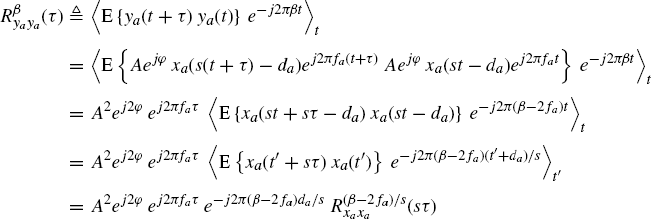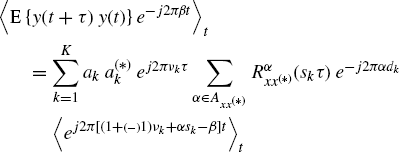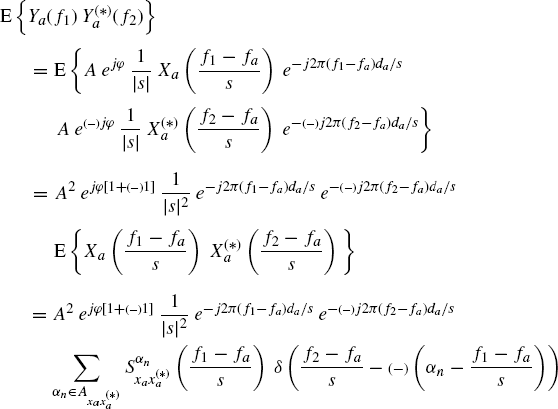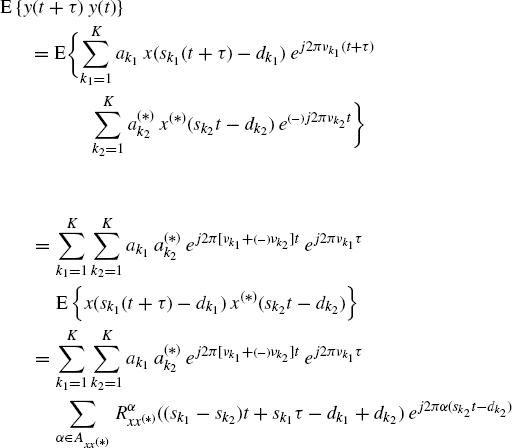7.10 Proofs
7.10.1 Proof of (7.262)
Fourier transform of a time-scaled, delayed, and frequency-shifted signal:
(7.383) ![]()
(7.384) ![]()
(7.385) 
7.10.2 Proof of (7.263) and (7.264)
By using (7.261), the result is that
where ![]() is the continuous-time infinite average with respect to t, and, in the third equality, the variable change t′ = st − da is made, so that
is the continuous-time infinite average with respect to t, and, in the third equality, the variable change t′ = st − da is made, so that
This proof can be equivalently carried out in the FOT approach by simply removing the expectation operator E{ · } in (7.386) and (7.387).
(7.264) is obtained by Fourier transforming both sides of (7.263).
7.10.3 Proof of (7.262) and (7.272)
By reasoning as for (7.386), we have
(7.388) 
(7.268) is obtained by Fourier transforming both sides of (7.267).
7.10.4 Proof of (7.273)
Accounting for (7.262) and (7.272), one obtains
from which (7.273) follows by a variable change in the argument of the Dirac delta (Zemanian 1987, Section 1.7).
7.10.5 Proof of (7.275)
Using (7.261), we have
(7.390) 
from which (7.275) immediately follows. The same result is obtained by taking the double inverse Fourier transform (see (1.15)) of both sides of (7.273) and then making the variable changes t1 = t + τ, t2 = t.
7.10.6 Proof of (7.276)
Accounting for (7.262), one obtains
(7.391) 
from which (7.276) immediately follows using (7.272).
7.10.7 Proof of (7.286) and (7.287)
Accounting for (7.284) and (1.88), we have
where the last equality is obtained by putting ![]() and
and ![]() into (1.88).
into (1.88).
Under assumption (1.89), ![]() . Thus, if
. Thus, if ![]() for k1 ≠ k2, then each term in the sum over α in (7.392) is a finite-strength additive sinewave component of the cyclic autocorrelation function only when k1 = k2 = k so that there is no dependence on t in the argument of
for k1 ≠ k2, then each term in the sum over α in (7.392) is a finite-strength additive sinewave component of the cyclic autocorrelation function only when k1 = k2 = k so that there is no dependence on t in the argument of ![]() . Thus we have the first and second equality in (7.286).
. Thus we have the first and second equality in (7.286).
By taking the Fourier coefficient at frequency β in (7.286) we have
(7.393) 
from which (7.287) easily follows observing that the last time average on t equals to the Kronecker delta ![]() .
.
Note that (7.287) can be obtained as special case of (Izzo and Napolitano 2002b, eq. (90)) for N = 2 with only the second optional complex conjugation present, by using (Izzo and Napolitano 1998a, eq. (36)) that expresses reduced-dimension (generalized) cyclic temporal moment functions in terms of (generalized) cyclic temporal moment functions.
7.10.8 Proof of Theorem 7.7.3 Doppler-Stretched Signal: Sampling Theorem for Loève Bifrequency Spectrum
Replicas in (7.325) are separated by 1 in both ν1 and ν2 variables. Thus, from (7.326a) it follows that fs ≥ 2B|s| is a sufficient condition such that replicas do not overlap. Note that, even if replicas do not overlap, the mapping νi = fi/fs, i = 1, 2, does not link (7.273) and (7.325) for νi ![]() [− 1/2, 1/2]. A sufficient condition to assure such a mapping or, equivalently, that only replica (n1, n2) in (7.325) lies in the square (ν1, ν2)
[− 1/2, 1/2]. A sufficient condition to assure such a mapping or, equivalently, that only replica (n1, n2) in (7.325) lies in the square (ν1, ν2) ![]() (n1 − 1/2, n1 + 1/2) × (n2 − 1/2, n2 + 1/2), according to (7.326b) is
(n1 − 1/2, n1 + 1/2) × (n2 − 1/2, n2 + 1/2), according to (7.326b) is ![]() , that is,
, that is, ![]() , where (7.298) is accounted for.
, where (7.298) is accounted for.
7.10.9 Proof of Theorem 7.7.4 Doppler Stretched Signal: Sampling Theorem for the Density of Loève Bifrequency Spectrum
According to (7.326a), if ![]() , the mapping ν1 = f1/fs for ν1
, the mapping ν1 = f1/fs for ν1 ![]() [− 1/2, 1/2] between the densities in (7.325) with n1 = n2 = 0 and those in (7.273) is assured provided that the support of replica with n1 = n2 = 0 does not intercept that of replicas with n1 = 0, n2 = ± 1. That is, on every support line
[− 1/2, 1/2] between the densities in (7.325) with n1 = n2 = 0 and those in (7.273) is assured provided that the support of replica with n1 = n2 = 0 does not intercept that of replicas with n1 = 0, n2 = ± 1. That is, on every support line
the following implication
must hold, where (7.394) is obtained by rearranging the argument of the Dirac delta in (7.325). From (7.394) with ![]() substituted into we have
substituted into we have
(7.396) 
where the bound for ![]() comes form (1.176b). Thus, inequality in (7.95) is satisfied provided that
comes form (1.176b). Thus, inequality in (7.95) is satisfied provided that ![]() that is, fs ≥ 2(2B|s| + |fa|).
that is, fs ≥ 2(2B|s| + |fa|).
These results agree with those in (Napolitano 2010b, Theorem 3) since (−)κ = κ.
7.10.10 Proof of Theorem 7.7.5 Doppler Stretched Signal: Sampling Theorem for the (Conjugate) Cyclic Spectrum
By setting ![]() and
and ![]() into the cyclic-spectrum support expression (1.176a), we have
into the cyclic-spectrum support expression (1.176a), we have
(7.397) 
where the last inclusion relationship holds provided that inequality fs ≥ȅ4(B|s| + |fa|) is satisfied. In fact, accounting for (7.298), such an inequality is equivalent to ![]() .
.
Replicas in (7.329) are separated by 1 in both ![]() and ν domains. Consequently, condition fs ≥ 4(B|s| + |fa|) assures that only replica with p = 0 and q = 0 gives nonzero contribution in the principal domain
and ν domains. Consequently, condition fs ≥ 4(B|s| + |fa|) assures that only replica with p = 0 and q = 0 gives nonzero contribution in the principal domain ![]() . Then, observing that only replicas with p = q = 0 are coincident in (7.329) and (7.330), equation (7.331) immediately follows.
. Then, observing that only replicas with p = q = 0 are coincident in (7.329) and (7.330), equation (7.331) immediately follows.
7.10.11 Proof of Theorem 7.7.6 Sampling Theorem for Loève Bifrequency Cross-Spectrum
Replicas in the aliasing formula (7.332) are separated by 1 in both ν1 and ν2 variables. Thus, from the support bound (7.333a) it follows that B|s|/fs ≤ 1/2 and B/fs ≤ 1/2 that is,
(7.398) ![]()
is a sufficient condition such that replicas do not overlap. Moreover, from (7.333b), it follows that a sufficient condition to obtain that only the replica (n1, n2) lies in the square (ν1, ν2) ![]() (n1 − 1/2, n1 + 1/2) × (n2 − 1/2, n2 + 1/2) is
(n1 − 1/2, n1 + 1/2) × (n2 − 1/2, n2 + 1/2) is ![]() and B/fs ≤ 1/2. Thus, accounting for (7.298), for the replica with n1 = n2 = 0 we have (7.334).
and B/fs ≤ 1/2. Thus, accounting for (7.298), for the replica with n1 = n2 = 0 we have (7.334).
7.10.12 Proof of Theorem 7.7.7 Sampling Theorem for the Density of Loève Bifrequency Cross-Spectrum
Due to (7.333a), the mapping ν1 = f1/fs1 for ν1 ![]() [− 1/2, 1/2] between the densities with n1 = n2 = 0 in (7.332) and those in (7.276) is assured provided that the support replica with n1 = n2 = 0 does not intercept that of the replica with n1 = 0, n2 = ± 1. That is, on every support line
[− 1/2, 1/2] between the densities with n1 = n2 = 0 in (7.332) and those in (7.276) is assured provided that the support replica with n1 = n2 = 0 does not intercept that of the replica with n1 = 0, n2 = ± 1. That is, on every support line
the following implication
must hold. From (7.399) with ![]() substituted into we have
substituted into we have
(7.401) 
Thus, inequality in (7.400) is satisfied provided that 3B/fs ≤ 1 − B/fs, that is, fs ≥ 4B. Then, accounting for (7.334), we obtain (7.336).
7.10.13 Proof of Theorem 7.7.8 Sampling Theorem for the (Conjugate) Cyclic Autocorrelation Function
From (7.339) (with y(n) = xs(n), A = 1, ϕ = 0, ![]() , and d = 0) it follows that
, and d = 0) it follows that
Thus, if ![]() or if
or if ![]() for |α| > fs/2, then for
for |α| > fs/2, then for ![]() the sum in the rhs of (7.339) equals the rhs of (7.402) and, hence,
the sum in the rhs of (7.339) equals the rhs of (7.402) and, hence, ![]() . A sufficient condition to assure
. A sufficient condition to assure ![]() for |α| > fs/2 is that the bandwidth of xas(t) is less than fs/2 (Section 1.3.9), (Napolitano 1995; Gardner et al. 2006). That is, B|s| ≤ fs/2, i.e., (7.340).
for |α| > fs/2 is that the bandwidth of xas(t) is less than fs/2 (Section 1.3.9), (Napolitano 1995; Gardner et al. 2006). That is, B|s| ≤ fs/2, i.e., (7.340).




